Best Management Practices Affect Water Quality in Coastal Watersheds
Abstract
1. Introduction
2. Materials and Methods
2.1. Study Area
2.2. SWAT Model
2.3. Dataset and Model Setup
2.4. Model Parameterization
2.5. Best Management Practices
2.5.1. Pond
2.5.2. Wetlands
2.5.3. Riparian Forest Buffer (RFB)/Streamside Management Zones (SMZ)
2.6. Model Performance Evaluation
3. Results and Discussions
3.1. Streamflow Calibration and Validation
3.2. TSS Calibration and Validation
3.3. MinP Calibration and Validation
3.4. Effectiveness of BMPs
3.4.1. Effectiveness of Pond
3.4.2. Effectiveness of Wetland
3.4.3. Effectiveness of RFB/SMZ
3.4.4. Effectiveness of Pond, Wetland, and RFB/SMZ Combined
4. Conclusions
Author Contributions
Funding
Institutional Review Board Statement
Informed Consent Statement
Data Availability Statement
Acknowledgments
Conflicts of Interest
References
- Lu, Y.; Yuan, J.; Lu, X.; Su, C.; Zhang, Y.; Wang, C.; Cao, X.; Li, Q.; Su, J.; Ittekkot, V.; et al. Major Threats of Pollution and Climate Change to Global Coastal Ecosystems and Enhanced Management for Sustainability. Environ. Pollut. 2018, 239, 670–680. [Google Scholar] [CrossRef] [PubMed]
- Bini, M.; Rossi, V. Climate Change and Anthropogenic Impact on Coastal Environments. Water 2021, 13, 1182. [Google Scholar] [CrossRef]
- Lu, Y.; Wang, P.; Wang, C.; Zhang, M.; Cao, X.; Chen, C.; Wang, C.; Xiu, C.; Du, D.; Cui, H.; et al. Multiple Pollutants Stress the Coastal Ecosystem with Climate and Anthropogenic Drivers. J. Hazard. Mater. 2022, 424, 127570. [Google Scholar] [CrossRef]
- Babcock, R.C.; Bustamante, R.H.; Fulton, E.A.; Fulton, D.J.; Haywood, M.D.E.; Hobday, A.J.; Kenyon, R.; Matear, R.J.; Plagányi, E.E.; Richardson, A.J.; et al. Severe Continental-Scale Impacts of Climate Change Are Happening Now: Extreme Climate Events Impact Marine Habitat Forming Communities along 45% of Australia’s Coast. Front. Mar. Sci. 2019, 6, 411. [Google Scholar] [CrossRef]
- Browning, T.N.; Sawyer, D.E. Vulnerability to Watershed Erosion and Coastal Deposition in the Tropics. Sci. Rep. 2021, 11, 1–11. [Google Scholar] [CrossRef]
- Kitchener, B.G.; Wainwright, J.; Parsons, A.J. A Review of the Principles of Turbidity Measurement. Prog. Phys. Geogr. 2017, 41, 620–642. [Google Scholar] [CrossRef]
- Cunning, R.; Silverstein, R.N.; Barnes, B.B.; Baker, A.C. Extensive Coral Mortality and Critical Habitat Loss Following Dredging and Their Association with Remotely-Sensed Sediment Plumes. Mar. Pollut. Bull. 2019, 145, 185–199. [Google Scholar] [CrossRef]
- Paerl, H.W.; Otten, T.G. Harmful Cyanobacterial Blooms: Causes, Consequences, and Controls. Microb. Ecol. 2013, 65, 995–1010. [Google Scholar] [CrossRef]
- Breitburg, D.L.; Craig, J.K.; Fulford, R.S.; Rose, K.A.; Boynton, W.R.; Brady, D.C.; Ciotti, B.J.; Diaz, R.J.; Friedland, K.D.; Hagy, J.D.; et al. Nutrient Enrichment and Fisheries Exploitation: Interactive Effects on Estuarine Living Resources and Their Management. Hydrobiologia 2009, 629, 31–47. [Google Scholar] [CrossRef]
- Shaver, E.C.; Shantz, A.A.; McMinds, R.; Burkepile, D.E.; Vega Thurber, R.L.; Silliman, B.R. Effects of Predation and Nutrient Enrichment on the Success and Microbiome of a Foundational Coral. Ecology 2017, 98, 830–839. [Google Scholar] [CrossRef] [PubMed]
- Oelsner, G.P.; Stets, E.G. Recent Trends in Nutrient and Sediment Loading to Coastal Areas of the Conterminous U.S.: Insights and Global Context. Sci. Total Environ. 2019, 654, 1225–1240. [Google Scholar] [CrossRef] [PubMed]
- Thrush, S.F.; Hewitt, J.E.; Cummings, V.J.; Ellis, J.I.; Hatton, C.; Lohrer, A.; Norkko, A. Muddy Waters: Elevating Sediment Input to Coastal and Estuarine Habitats. Front. Ecol. Environ. 2004, 2, 299–306. [Google Scholar] [CrossRef]
- López-Ballesteros, A.; Senent-Aparicio, J.; Srinivasan, R.; Pérez-Sánchez, J. Assessing the Impact of Best Management Practices in a Highly Anthropogenic and Ungauged Watershed Using the SWAT Model: A Case Study in the El Beal Watershed (Southeast Spain). Agronomy 2019, 9, 576. [Google Scholar] [CrossRef]
- Fox, R.J.; Fisher, T.R.; Gustafson, A.B.; Koontz, E.L.; Lepori-Bui, M.; Kvalnes, K.L.; Bunnell-Young, D.E.; Gardner, J.R.; Lewis, J.; Winsten, J.R.; et al. An Evaluation of the Chesapeake Bay Management Strategy to Improve Water Quality in Small Agricultural Watersheds. J. Environ. Manag. 2021, 299, 113478. [Google Scholar] [CrossRef]
- Simpson, T.W.; Weammert, S.E. Revising BMP Efficiencies for the Chesapeake Bay Watershed: Challenges and Lessons Learned. In Proceedings of the American Society of Agricultural and Biological Engineers—Conference on 21st Century Watershed Technology: Improving Water Quality and Environment 2008, Concepcion, Chile, 29 March–3 April 2008. [Google Scholar]
- Hawks, B.S.; Aust, W.M.; Bolding, M.C.; Barrett, S.M.; Schilling, E.B. Audit Procedures and Implementation Rates for Forest Water Quality Best Management Practices in the 13 Southeastern States. J. Soil Water Conserv. 2022, 77, 501–515. [Google Scholar] [CrossRef]
- Sith, R.; Watanabe, A.; Nakamura, T.; Yamamoto, T.; Nadaoka, K. Assessment of Water Quality and Evaluation of Best Management Practices in a Small Agricultural Watershed Adjacent to Coral Reef Area in Japan. Agric. Water Manag. 2019, 213, 659–673. [Google Scholar] [CrossRef]
- Jang, T.; Vellidis, G.; Kurkalova, L.A.; Boll, J.; Hyman, J.B. Prioritizing Watersheds for Conservation Actions in the Southeastern Coastal Plain Ecoregion. Environ. Manag. 2015, 55, 657–670. [Google Scholar] [CrossRef]
- Arnillas, C.A.; Yang, C.; Zamaria, S.A.; Neumann, A.; Javed, A.; Shimoda, Y.; Feisthauer, N.; Crolla, A.; Dong, F.; Blukacz-Richards, A.; et al. Integrating Watershed and Ecosystem Service Models to Assess Best Management Practice Efficiency: Guidelines for Lake Erie Managers and Watershed Modellers. Environ. Rev. 2021, 29, 31–63. [Google Scholar] [CrossRef]
- Fares, A.; El-Kadi, E.-K. Coastal Watershed Management; WIT Press: Billerica, MA, USA, 1848; ISBN 9781845640910. [Google Scholar]
- Arnold, J.G.; Srinivasan, R.; Muttiah, R.S.; Williams, J.R. Large Area Hydrologic Modeling and Assessment Part I: Model Development 1. J. Am. Water Resour. Assoc. 1998, 34, 73–89. [Google Scholar] [CrossRef]
- Wu, K.; Xu, Y.J. Evaluation of the Applicability of the SWAT Model for Coastal Watersheds in Southeastern Louisiana1. JAWRA J. Am. Water Resour. Assoc. 2006, 42, 1247–1260. [Google Scholar] [CrossRef]
- Upadhyay, P.; Linhoss, A.; Kelble, C.; Ashby, S.; Murphy, N.; Parajuli, P.B. Applications of the SWAT Model for Coastal Watersheds: Review and Recommendations. J. ASABE 2022, 65, 453–469. [Google Scholar] [CrossRef]
- Amatya, D.M.; Jha, M.K. Evaluating the SWAT Model for a Low-Gradient Forested Watershed in Coastal South Carolina. Trans. ASABE 2011, 54, 2151–2163. [Google Scholar] [CrossRef]
- Shao, H.; Yang, W.; Lindsay, J.; Liu, Y.; Yu, Z.; Oginskyy, A. An Open Source GIS-Based Decision Support System for Watershed Evaluation of Best Management Practices. JAWRA J. Am. Water Resour. Assoc. 2017, 53, 521–531. [Google Scholar] [CrossRef]
- Mitsch, W.J.; Day, J.W.; Gilliam, J.W.; Groffman, P.M.; Hey, D.L.; Randall, G.W.; Wang, N. Reducing Nitrogen Loading to the Gulf of Mexico from the Mississippi River Basin: Strategies to Counter a Persistent Ecological Problem. Bioscience 2001, 51, 373–388. [Google Scholar] [CrossRef]
- MARIS. Available online: https://maris.mississippi.edu/ (accessed on 15 August 2022).
- Liu, Z.; Kingery, W.L.; Huddleston, D.H.; Hossain, F.; Hashim, N.B.; Kieffer, J.M. Assessment of Water Quality Conditions in the St. Louis Bay Watershed. J. Environ. Sci. Heal. Part A 2008, 43, 468–477. [Google Scholar] [CrossRef] [PubMed]
- Sawant, P.A. Factors Influencing the Environmental Quality of the Bay of Saint Louis, Mississippi and Implications for Evolving Coastal Management Policies. Ph.D. Thesis, The University of Southern Mississippi, Hattiesburg, MS, USA, 2009. [Google Scholar]
- Spaid, H. Contribution of Submarine Groundwater Discharge to Select Biogeochemical Fluxes in St. Louis Bay, Mississippi. Master’s Thesis, The University of Southern Mississippi, Hattiesburg, MS, USA, 2020. [Google Scholar]
- Bhattarai, S.; Parajuli, P.B.; To, F. Comparison of Flood Frequency at Different Climatic Scenarios in Forested Coastal Watersheds. Climate 2023, 11, 41. [Google Scholar] [CrossRef]
- Wang, Y.; Jiang, R.; Xie, J.; Zhao, Y.; Yan, D.; Yang, S. Soil and Water Assessment Tool (SWAT) Model: A Systemic Review. J. Coast. Res. 2019, 93, 22–30. [Google Scholar] [CrossRef]
- Gassman, P.W.; Reyes, M.R.; Green, C.H.; Arnold, J.G.; Gassman, P.W. The Soil and Water Assessment Tool: Historical Development, Applications, and Future Research Directions. Trans. ASABE 2007, 50, 1211–1250. [Google Scholar] [CrossRef]
- USGS The National Map-Advanced Viewer. Available online: https://apps.nationalmap.gov/ (accessed on 15 May 2022).
- CropScape—NASS CDL Program. Available online: https://nassgeodata.gmu.edu/CropScape/ (accessed on 15 May 2022).
- Global Data|SWAT|Soil & Water Assessment Tool. Available online: https://swat.tamu.edu/data/ (accessed on 15 May 2022).
- NOAA Climate Data Online (CDO)-National Climatic Data Center (NCDC). Available online: https://www.ncdc.noaa.gov/cdo-web/ (accessed on 16 May 2022).
- Zhang, H.; Wang, B.; Li Liu, D.; Zhang, M.; Leslie, L.M.; Yu, Q. Using an Improved SWAT Model to Simulate Hydrological Responses to Land Use Change: A Case Study of a Catchment in Tropical Australia. J. Hydrol. 2020, 585, 124822. [Google Scholar] [CrossRef]
- Haas, H.; Reaver, N.G.; Karki, R.; Kalin, L.; Srivastava, P.; Kaplan, D.A.; Gonzalez-Benecke, C. Improving the Representation of Forests in Hydrological Models. Sci. Total Environ. 2022, 812, 151425. [Google Scholar] [CrossRef]
- Poorter, H.; Niklas, K.J.; Reich, P.B.; Oleksyn, J.; Poot, P.; Mommer, L. Biomass Allocation to Leaves, Stems and Roots: Meta-Analyses of Interspecific Variation and Environmental Control. New Phytol. 2012, 193, 30–50. [Google Scholar] [CrossRef] [PubMed]
- USGS Water Data for Mississippi. Available online: https://waterdata.usgs.gov/ms/nwis/ (accessed on 18 May 2022).
- Abbaspour, K.C. SWAT-Cup 2012. SWAT Calibration and Uncertainty Program—A User Manual; Eawag Swiss Federal Institute of Aquatic Science and Technology: Dübendorf, Switzerland, 2013. [Google Scholar]
- Abell, R.; Vigerstol, K.; Higgins, J.; Kang, S.; Karres, N.; Lehner, B.; Sridhar, A.; Chapin, E. Freshwater Biodiversity Conservation through Source Water Protection: Quantifying the Potential and Addressing the Challenges. Aquat. Conserv. Mar. Freshw. Ecosyst. 2019, 29, 1022–1038. [Google Scholar] [CrossRef]
- Hawks, B.S.; Aust, W.M.; Bolding, M.C.; Barrett, S.M.; Schilling, E.; Fielding, J.A. Linkages between Forestry Best Management Practices and Erosion in the Southeastern US. J. Environ. Manag. 2022, 305, 114411. [Google Scholar] [CrossRef] [PubMed]
- Liu, Y.; Engel, B.A.; Flanagan, D.C.; Gitau, M.W.; McMillan, S.K.; Chaubey, I. A Review on Effectiveness of Best Management Practices in Improving Hydrology and Water Quality: Needs and Opportunities. Sci. Total Environ. 2017, 601–602, 580–593. [Google Scholar] [CrossRef]
- NRCS. Conservation Practice Standard Pond (Code 378); NRCS, USA, 2022. Available online: https://www.nrcs.usda.gov/sites/default/files/2022-09/Pond_378_NHCP_CPS_2022.pdf (accessed on 20 May 2022).
- National Agriculture Imagery Program—NAIP Hub Site. Available online: https://naip-usdaonline.hub.arcgis.com/ (accessed on 18 January 2023).
- Risal, A.; Parajuli, P.B. Evaluation of the Impact of Best Management Practices on Streamflow, Sediment and Nutrient Yield at Field and Watershed Scales. Water Resour. Manag. 2022, 36, 1093–1105. [Google Scholar] [CrossRef]
- NRCS. Irrigation Guide; NRCS: Stanton, NE, USA, 1997. Available online: https://directives.sc.egov.usda.gov/OpenNonWebContent.aspx?content=17837.wba (accessed on 20 May 2022).
- Chang, H.; Makido, Y.; Foster, E. Effects of Land Use Change, Wetland Fragmentation, and Best Management Practices on Total Suspended Solids Concentrations in an Urbanizing Oregon Watershed, USA. J. Environ. Manag. 2021, 282, 111962. [Google Scholar] [CrossRef]
- National Wetlands Inventory|U.S. Fish & Wildlife Service. Available online: https://www.fws.gov/program/national-wetlands-inventory (accessed on 18 June 2022).
- Li, H. Integrating Forests into Water Quality Trading by Identifying Runoff and Sediment Yield Reduction Effect Using Swat Modeling in East Texas. Ph.D. Thesis, Stephen F. Austin State University, Austin, TX, USA, 2015. [Google Scholar]
- Mississippi Forestry Commission. Best Management Practices for Forestry in Mississippi; Mississippi Forestry Commission: Jackson, MS, USA, 2008. [Google Scholar]
- Krause, P.; Boyle, D.P.; Bäse, F. Comparison of Different Efficiency Criteria for Hydrological Model Assessment. Adv. Geosci. 2005, 5, 89–97. [Google Scholar] [CrossRef]
- Nash, J.E.; Sutcliffe, J.V. River Flow Forecasting through Conceptual Models Part I—A Discussion of Principles. J. Hydrol. 1970, 10, 282–290. [Google Scholar] [CrossRef]
- Leta, O.T.; El-Kadi, A.I.; Dulai, H.; Ghazal, K.A. Assessment of SWAT Model Performance in Simulating Daily Streamflow under Rainfall Data Scarcity in Pacific Island Watersheds. Water 2018, 10, 1533. [Google Scholar] [CrossRef]
- Roth, V.; Lemann, T. Comparing CFSR and Conventional Weather Data for Discharge and Soil Loss Modelling with SWAT in Small Catchments in the Ethiopian Highlands. Hydrol. Earth Syst. Sci. 2016, 20, 921–934. [Google Scholar] [CrossRef]
- Zeiger, S.J.; Owen, M.R.; Pavlowsky, R.T. Simulating Nonpoint Source Pollutant Loading in a Karst Basin: A SWAT Modeling Application. Sci. Total Environ. 2021, 785, 147295. [Google Scholar] [CrossRef]
- Addis, H.K.; Strohmeier, S.; Ziadat, F.; Melaku, N.D.; Klik, A. Modeling Streamflow and Sediment Using SWAT in Ethiopian Highlands. Int. J. Agric. Biol. Eng. 2016, 9, 51–66. [Google Scholar] [CrossRef]
- Dechmi, F.; Burguete, J.; Skhiri, A. SWAT Application in Intensive Irrigation Systems: Model Modification, Calibration and Validation. J. Hydrol. 2012, 470–471, 227–238. [Google Scholar] [CrossRef]
- Molina-Navarro, E.; Andersen, H.E.; Nielsen, A.; Thodsen, H.; Trolle, D. The Impact of the Objective Function in Multi-Site and Multi-Variable Calibration of the SWAT Model. Environ. Model. Softw. 2017, 93, 255–267. [Google Scholar] [CrossRef]
- Chiang, L.C.; Liao, C.J.; Lu, C.M.; Wang, Y.C. Applicability of Modified SWAT Model (SWAT-Twn) on Simulation of Watershed Sediment Yields under Different Land Use/Cover Scenarios in Taiwan. Environ. Monit. Assess. 2021, 193, 1–23. [Google Scholar] [CrossRef]
- Storm Events Database | National Centers for Environmental Information. Available online: https://www.ncdc.noaa.gov/stormevents/ (accessed on 28 June 2022).
- Fiener, P.; Auerswald, K.; Weigand, S. Managing Erosion and Water Quality in Agricultural Watersheds by Small Detention Ponds. Agric. Ecosyst. Environ. 2005, 110, 132–142. [Google Scholar] [CrossRef]
- Alami, M.T.; Abbasi, H.; Niksokhan, M.H.; Zarghami, M. Charged System Search for Optimum Design of Cost-Effective Structural Best Management Practices for Improving Water Quality. Int. J. Optim. Civ. Eng. 2018, 8, 295–309. [Google Scholar]
- Bekele, E.G.; Demissie, M.; Lian, Y. Optimizing the Placement of Best Management Practices (BMPs) in Agriculturally-Dominated Watersheds in Illinois. World Environ. Water Resour. Congr. 2011 Bear. Knowl. Sustain. 2011, 2890–2900. [Google Scholar] [CrossRef]
- Leh, M.D.; Sharpley, A.N.; Singh, G.; Matlock, M.D. Assessing the Impact of the MRBI Program in a Data Limited Arkansas Watershed Using the SWAT Model. Agric. Water Manag. 2018, 202, 202–219. [Google Scholar] [CrossRef]
- Jalowska, A.M.; Yuan, Y. Evaluation of SWAT Impoundment Modeling Methods in Water and Sediment Simulations. JAWRA J. Am. Water Resour. Assoc. 2019, 55, 209–227. [Google Scholar] [CrossRef] [PubMed]
- Elçi, A. Evaluation of Nutrient Retention in Vegetated Filter Strips Using the SWAT Model. Water Sci. Technol. 2017, 76, 2742–2752. [Google Scholar] [CrossRef] [PubMed]
- Saksa, P.; Xu, Y.J.; Stich, R. Hydrologic Influence on Sediment Transport of Low-Gradient, Forested Headwater Streams in Central Louisiana. In Proceedings of the 15th Biennial Southern Silvicultural Research Conference, Asheville, NC, USA; 2010; pp. 551–558. Available online: https://www.srs.fs.usda.gov/pubs/gtr/gtr_srs175/gtr_srs175_551.pdf (accessed on 20 May 2022).
- Sirabahenda, Z.; St-Hilaire, A.; Courtenay, S.C.; Van Den Heuvel, M.R. Assessment of the Effective Width of Riparian Buffer Strips to Reduce Suspended Sediment in an Agricultural Landscape Using ANFIS and SWAT Models. CATENA 2020, 195, 104762. [Google Scholar] [CrossRef]
- Venishetty, V.; Parajuli, P.B. Assessment of BMPs by Estimating Hydrologic and Water Quality Outputs Using SWAT in Yazoo River Watershed. Agriculture 2022, 12, 477. [Google Scholar] [CrossRef]
- Nepal, D.; Parajuli, P.B. Assessment of Best Management Practices on Hydrology and Sediment Yield at Watershed Scale in Mississippi Using SWAT. Agriculture 2022, 12, 518. [Google Scholar] [CrossRef]


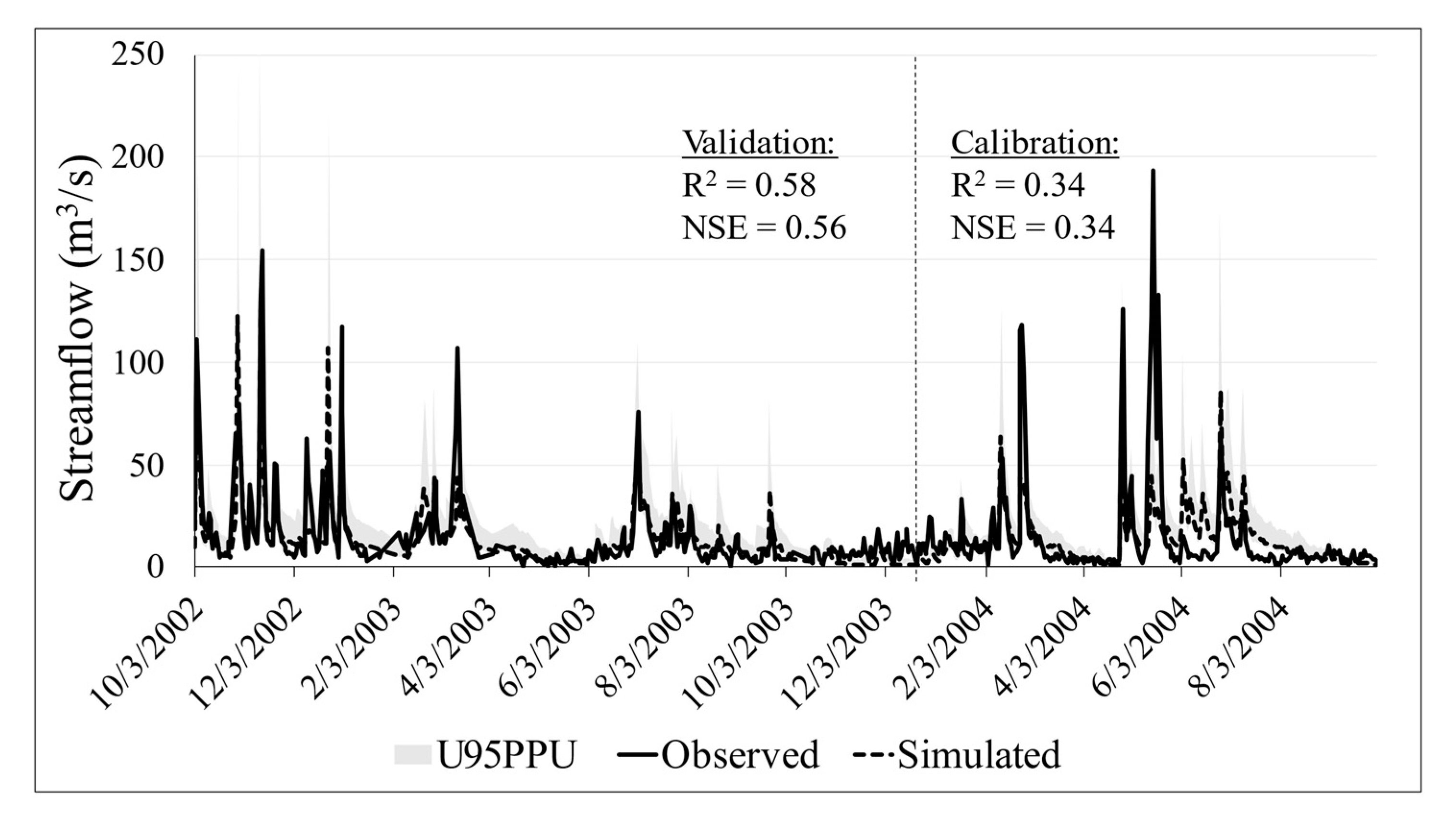
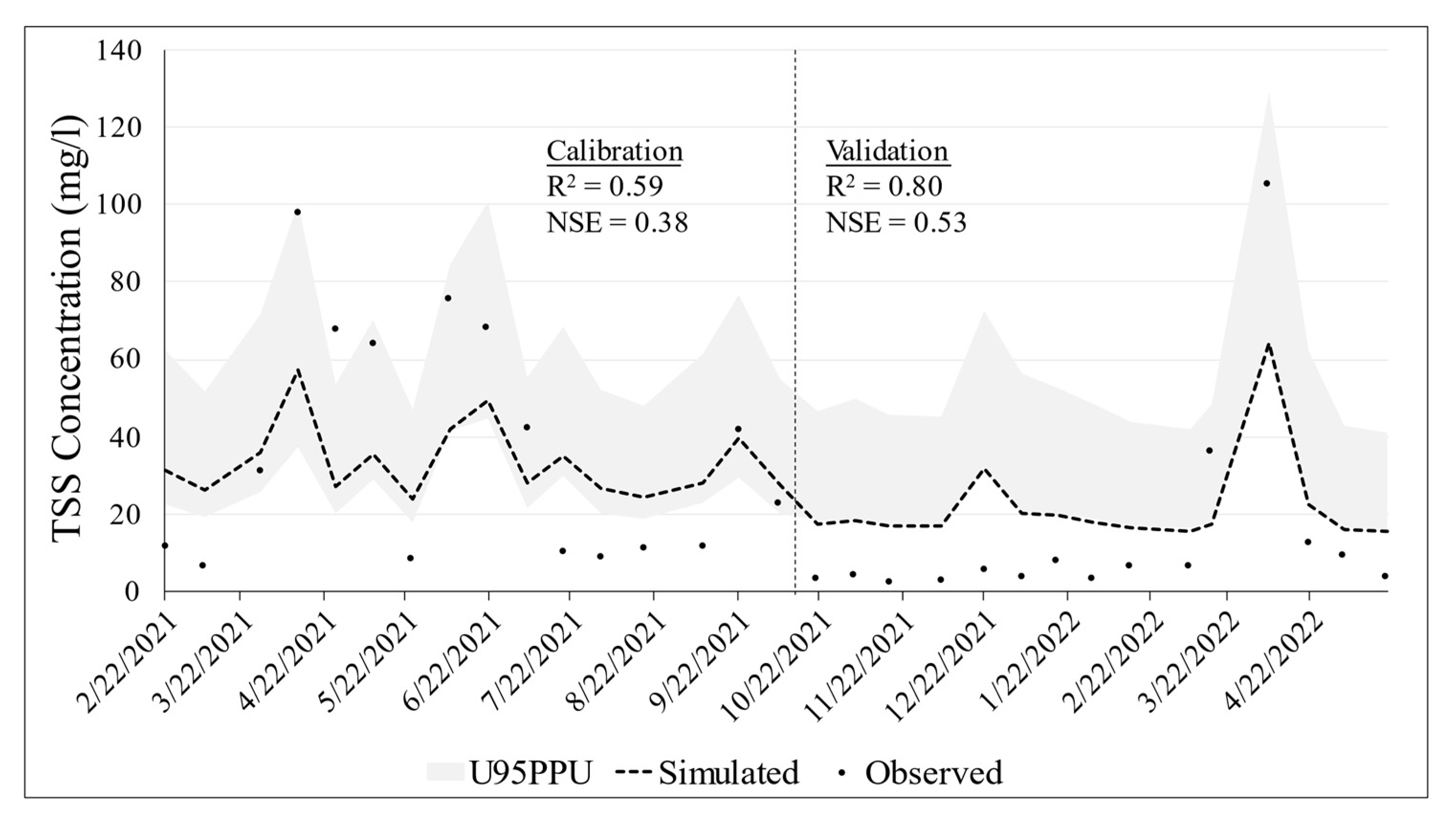
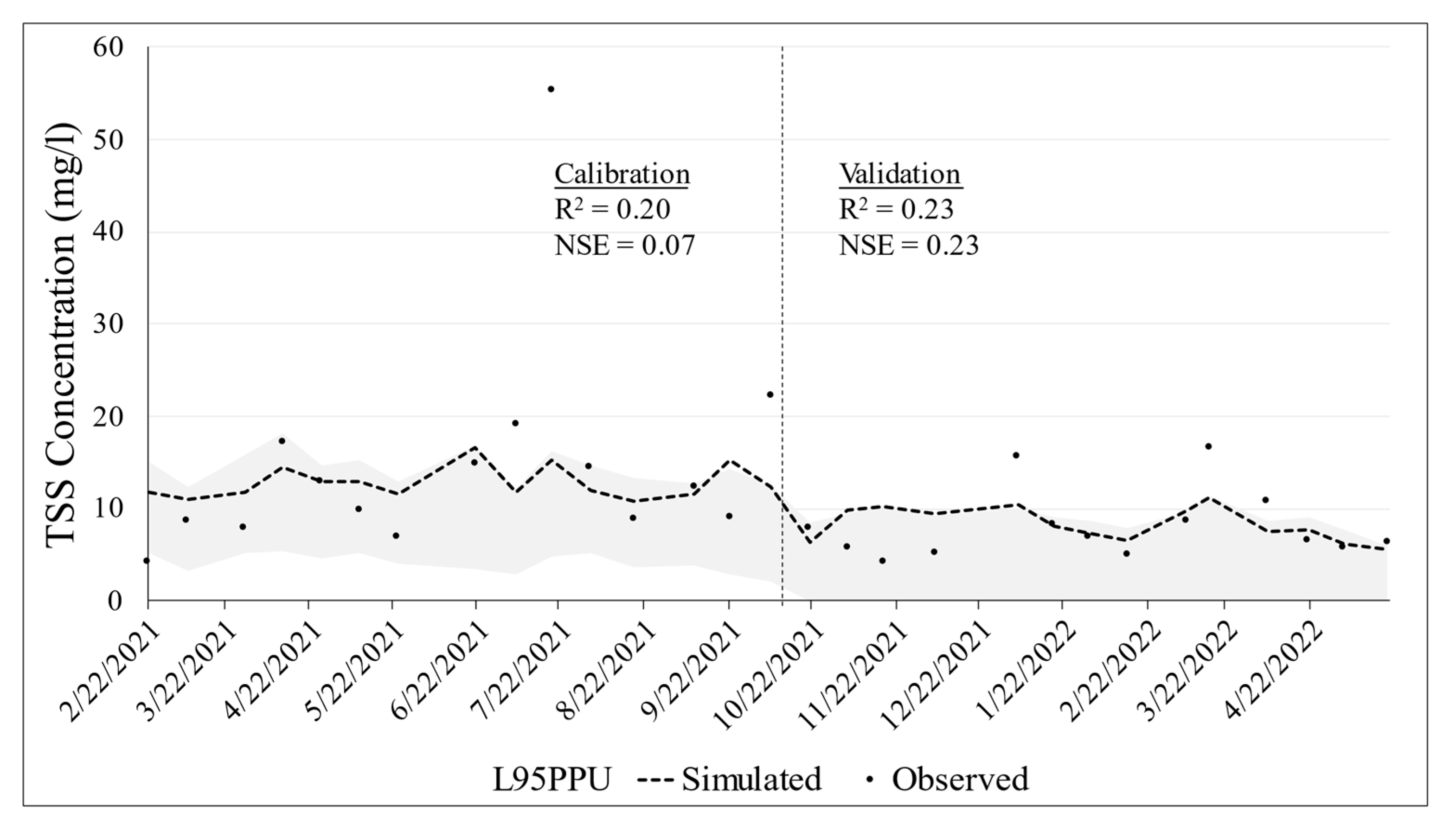

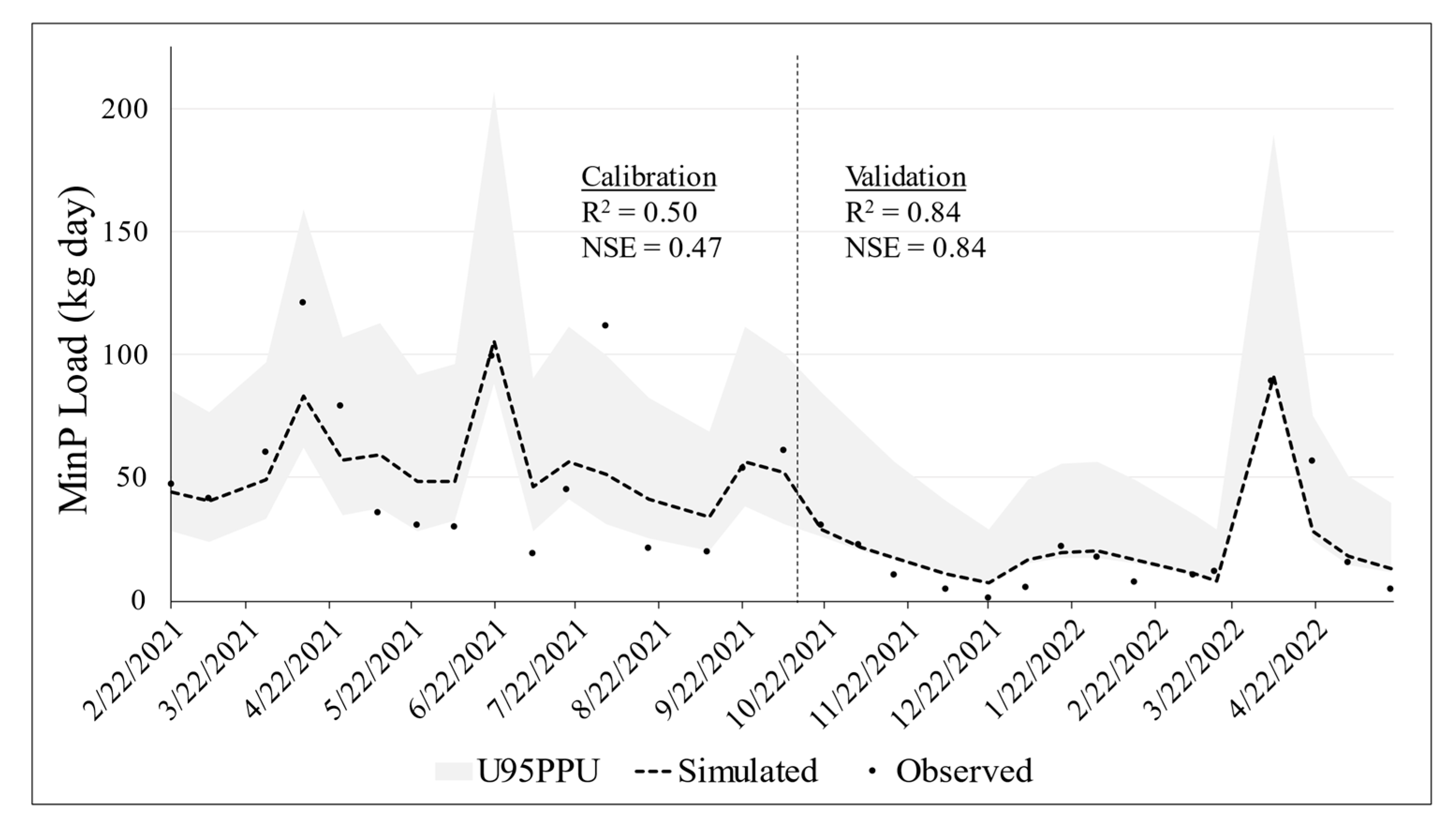
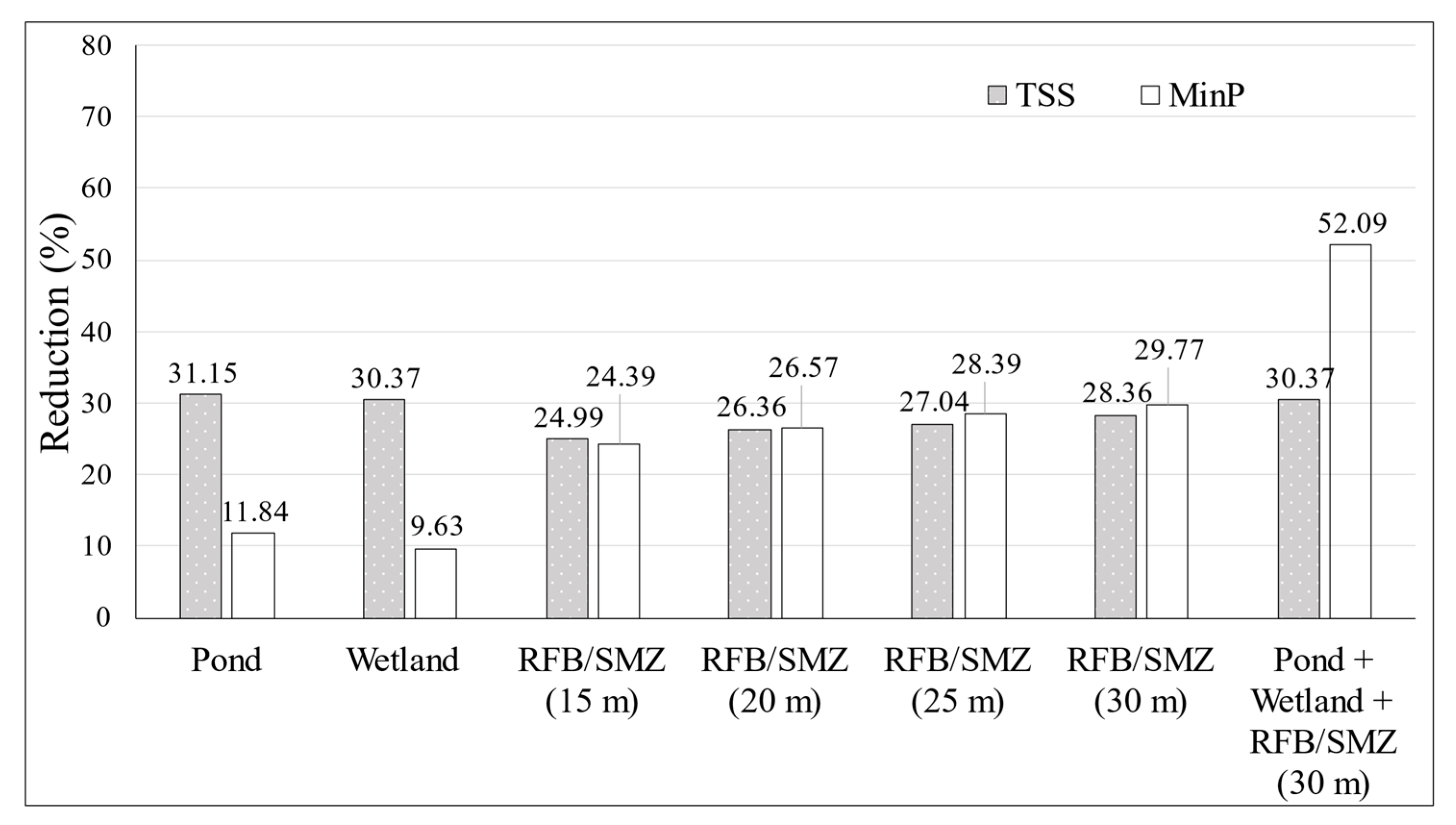
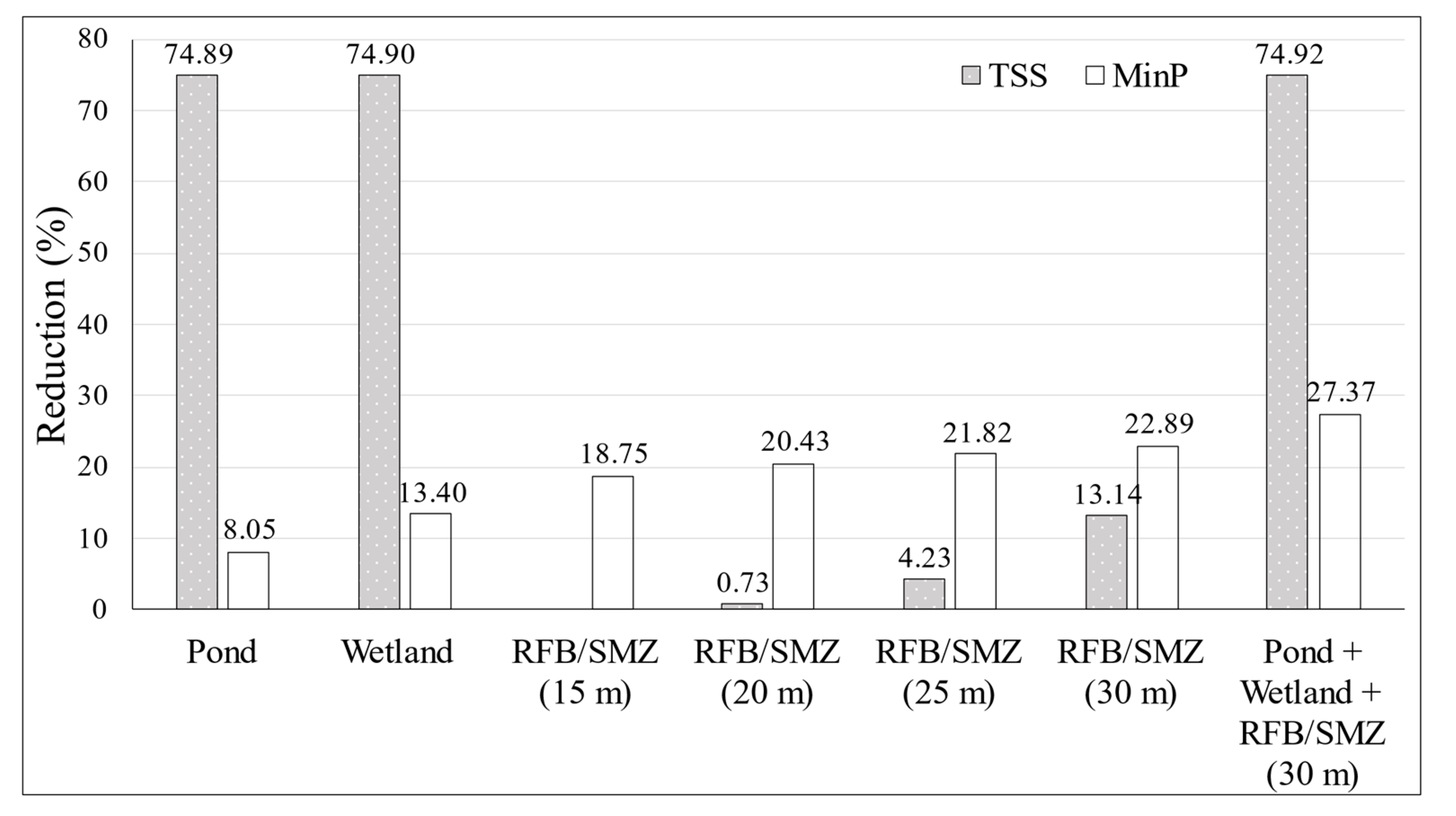
| Parameter | Description | Range | Fitted Value | ||
|---|---|---|---|---|---|
| Min | Max | WRW | JRW | ||
| Flow | |||||
| r__CN2.mgt | Initial SCS runoff curve number for moisture condition II. | −0.2 | 0.2 | 0.179 | −0.196 |
| v__ALPHA_BF.gw | Baseflow alpha factor (days). | 0 | 1 | 0.679 | 0.886 |
| v__GW_DELAY.gw | Groundwater delay (days). | 30 | 450 | 374.699 | 31.235 |
| v__EPCO.hru | Plant uptake compensation factor. | 0 | 1 | 0.320 | 0.418 |
| v__ESCO.hru | Soil evaporation compensation factor. | 0 | 1 | 0.390 | 0.106 |
| v__RCHRG_DP.gw | Deep aquifer percolation fraction. | 0 | 1 | 0.008 | 0.124 |
| v__GW_REVAP.gw | Groundwater “revap” coefficient. | 0.02 | 0.2 | 0.056 | 0.135 |
| v__CH_N2.rte | Manning’s “n” value for the main channel. | −0.01 | 0.3 | 0.051 | 0.243 |
| v__CH_K2.rte | Effective hydraulic conductivity in main channel alluvium. | −0.01 | 500 | 425.603 | 16.818 |
| v__ALPHA_BNK.rte | Baseflow alpha factor for bank storage. | 0 | 1 | 0.976 | 0.980 |
| r__SOL_K().sol | Saturated hydraulic conductivity. | −0.3 | 0.3 | 0.016 | 0.275 |
| r__SOL_BD().sol | Moist bulk density. | −0.3 | 0.3 | 0.277 | 0.225 |
| r__OV_N.hru | Manning’s “n” value for overland flow. | −0.3 | 0.3 | −0.033 | 0.296 |
| v__CANMX.hru | Maximum canopy storage. | 0 | 100 | 49.196 | 7.779 |
| r__SLSUBBSN.hru | Average slope length. | −0.5 | 0.5 | −0.292 | 0.0989 |
| v__GWQMN.gw | Threshold depth of water in the shallow aquifer required for return flow to occur (mm). | 0 | 5000 | - | 1229.617 |
| v__REVAPMN.gw | Threshold depth of water in the shallow aquifer for “revap” to occur (mm). | 0 | 500 | - | 257.009 |
| r__SOL_AWC().sol | Available water capacity of the soil layer. | −0.3 | 0.3 | - | −0.014 |
| v__SURLAG.bsn | Surface runoff lag time. | 0.05 | 24 | - | 8.322 |
| v__LAT_TTIME.hru | Lateral flow travel time. | 0 | 25 | - | 1.954 |
| v__CNCOEF.bsn | Plant ET curve number coefficient. | 0.5 | 1 | - | 0.825 |
| Parameter | Description | Range | Fitted Value | ||
|---|---|---|---|---|---|
| Min | Max | WRW | JRW | ||
| TSS | |||||
| v__CH_COV1.rte | Channel erodibility factor. | −0.05 | 0.6 | 0.244 | 0.090 |
| v__CH_COV2.rte | Channel cover factor. | −0.001 | 1 | 0.618 | 0.284 |
| v__USLE_P.mgt | USLE equation support practice factor. | 0 | 1 | 0.702 | 0.601 |
| r__USLE_K().sol | USLE equation soil erodibility (K) factor. | 0 | 0.65 | 0.428 | 0.609 |
| v__SPCON.bsn | Linear parameter for calculating the maximum amount of sediment that can be re-entrained during channel sediment routing. | 0.0001 | 0.01 | 0.0032 | - |
| v__SPEXP.bsn | Exponent parameter for calculating sediment reentrained in channel sediment routing. | 1 | 1.5 | 1.369 | 1.319 |
| v__CH_ERODMO().rte | Channel erodability factor. | 0 | 1 | - | 0.328 |
| v__ADJ_PKR.bsn | Peak rate adjustment factor for sediment routing in the subbasin (tributary channels). | 0.5 | 2 | - | 1.099 |
| r__HRU_SLP.hru | Average slope steepness. | 0.2 | 0.4 | - | 0.3995 |
| v__LAT_SED.hru | Sediment concentration in lateral flow and groundwater flow. | 0 | 5000 | - | 2253.221 |
| v__CH_WDR.rte | Channel width–depth ratio. | 0 | 10,000 | - | 5717.201 |
| v__CH_BNK_BD.rte | Bulk density of channel bank sediment (g/cc). | 1.1 | 1.9 | - | 1.729 |
| v__CH_BED_BD.rte | Bulk density of channel bed sediment (g/cc). | 1.1 | 1.9 | - | 1.786 |
| v__CH_W2.rte | Average width of main channel. | 0 | 1000 | - | 18.014 |
| Parameter | Description | Range | Fitted Value | ||
|---|---|---|---|---|---|
| Min | Max | WRW | JRW | ||
| MinP | |||||
| v__CMN.bsn | Rate factor for humus mineralization of active organic nitrogen. | 0.001 | 0.003 | 0.001 | 0.002 |
| v__PPERCO.bsn | Phosphorus percolation coefficient. | 10 | 17.5 | 12.91 | - |
| v__RS5.swq | Organic phosphorus settling rate in the reach at 20 °C [1/day]. | 0.001 | 0.1 | 0.043 | - |
| v__ERORGP.hru | Organic P enrichment ratio. | 0 | 5 | 2.269 | 4.909 |
| v__K_P.wwq | Michaelis–Menton half-saturation constant for phosphorus. | 0.001 | 0.05 | 0.031 | - |
| v__PHOSKD.bsn | Phosphorus soil partitioning coefficient. | 100 | 200 | 108.49 | - |
| v__GWSOLP.gw | Concentration of soluble phosphorus in groundwater contribution to streamflow from subbasin (mg P/L). | 0 | 0.03 | 0.021 | 0.024 |
| v__AI2.wwq | Fraction of algal biomass that is phosphorus. | 0.01 | 0.02 | - | 0.017 |
| v__BC4.swq | Rate constant for mineralization of organic P to dissolved P in the reach at 20 °C [1/day]. | 0.01 | 0.7 | - | 0.417 |
| v__RS2.swq | Benthic (sediment) source rate for dissolved phosphorus in the reach at 20 °C [mg/(m2. day)]. | 0.001 | 0.1 | - | 0.069 |
Disclaimer/Publisher’s Note: The statements, opinions and data contained in all publications are solely those of the individual author(s) and contributor(s) and not of MDPI and/or the editor(s). MDPI and/or the editor(s) disclaim responsibility for any injury to people or property resulting from any ideas, methods, instructions or products referred to in the content. |
© 2023 by the authors. Licensee MDPI, Basel, Switzerland. This article is an open access article distributed under the terms and conditions of the Creative Commons Attribution (CC BY) license (https://creativecommons.org/licenses/by/4.0/).
Share and Cite
Bhattarai, S.; Parajuli, P.B. Best Management Practices Affect Water Quality in Coastal Watersheds. Sustainability 2023, 15, 4045. https://doi.org/10.3390/su15054045
Bhattarai S, Parajuli PB. Best Management Practices Affect Water Quality in Coastal Watersheds. Sustainability. 2023; 15(5):4045. https://doi.org/10.3390/su15054045
Chicago/Turabian StyleBhattarai, Shreeya, and Prem B. Parajuli. 2023. "Best Management Practices Affect Water Quality in Coastal Watersheds" Sustainability 15, no. 5: 4045. https://doi.org/10.3390/su15054045
APA StyleBhattarai, S., & Parajuli, P. B. (2023). Best Management Practices Affect Water Quality in Coastal Watersheds. Sustainability, 15(5), 4045. https://doi.org/10.3390/su15054045





